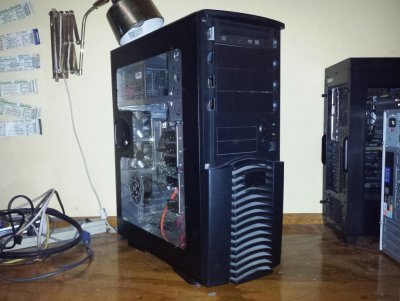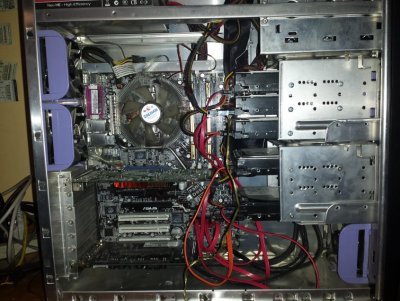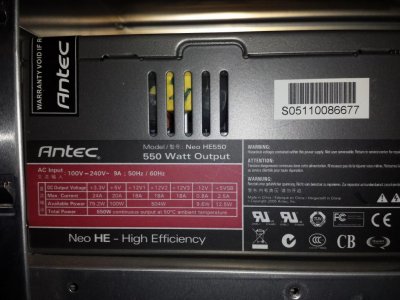I don't think it's a SX1000. I found a picture of one and it's white and no side window. When you gut it out look carefully on the bottom inside and on the outside of the bottom. Most case makers worth their salt will have a tag or stamp in the model number.
You are using an out of date browser. It may not display this or other websites correctly.
You should upgrade or use an alternative browser.
You should upgrade or use an alternative browser.
You're So 2000-and-late
- Thread starter OhSnapWord
- Start date
~Darkseeker~
Fully Optimized
- Messages
- 2,494
- Location
- Welwyn Garden City, United Kingdom
I'm sure I had a PC very much like that in the past, but it was a Packard Bell OEM machine - back when they had a killer performance line and didn't just make Dixons retail-esque crap.
Athlon 4200 and two 7600GTs in SLI
EDIT: Found a picture of it in the depths of my facebook. The bottom one in this picture (it was ruddy huge)

Athlon 4200 and two 7600GTs in SLI
EDIT: Found a picture of it in the depths of my facebook. The bottom one in this picture (it was ruddy huge)

Last edited:
OhSnapWord
Fully Optimized
- Messages
- 1,853
- Location
- USA
Well, I just made an executive decision. I'm going to throw some light mods at the case and build a more modern rig inside it. Submitted for your approval, Project 2000-Late.
Aside from the case, I am also reusing the power supply. At 550W, it's powerful enough for what I plan on doing.
This case is at least 10 years old. It offers no cable management, as evidenced by the pictures. These were taken after I put forward an effort, albeit half-assed one, to clean up the wiring. There's maybe a half inch between the back of the motherboard try and the right side panel.
So far, I plan on deleting the bottom hard drive cage to make room for a 120mm fan and enlarging the fan on the side to 120mm.
I have some parts laying around, but I do need to pick up some others. This is going to be a long term project as I come up with money to piece it together.
Stay tuned.
Aside from the case, I am also reusing the power supply. At 550W, it's powerful enough for what I plan on doing.
This case is at least 10 years old. It offers no cable management, as evidenced by the pictures. These were taken after I put forward an effort, albeit half-assed one, to clean up the wiring. There's maybe a half inch between the back of the motherboard try and the right side panel.
So far, I plan on deleting the bottom hard drive cage to make room for a 120mm fan and enlarging the fan on the side to 120mm.
I have some parts laying around, but I do need to pick up some others. This is going to be a long term project as I come up with money to piece it together.
Stay tuned.
Attachments
OhSnapWord
Fully Optimized
- Messages
- 1,853
- Location
- USA
And, here's the part's list at this point.
AMD FX-6300 - Project 2000-Late - ntria91's Saved Part List - PCPartPicker
I have an old Radeon HD 5450 that I'll use until I upgrade the graphics in my main rig. The CPU cooler I'm going with is a Cooler Master Hyper TX3. The Hyper 212 is a bit too tall for this case.
AMD FX-6300 - Project 2000-Late - ntria91's Saved Part List - PCPartPicker
I have an old Radeon HD 5450 that I'll use until I upgrade the graphics in my main rig. The CPU cooler I'm going with is a Cooler Master Hyper TX3. The Hyper 212 is a bit too tall for this case.
cb600fshornet
Fully Optimized
- Messages
- 2,190
- Location
- England, Birmingham
I think in cases where there is no dedicated cable management system, the cables look better when you tie them together rather than try to hide them. Obviously hiding away the cables that aren't used is good, but I tend to tie the power cables in one "trunk," and then have each cable split off to it's relevant spot. I don't tie the SATA data cables to the power cables (for obvious reasons), but I do try to run them vertically downwards (in most cases), then across, then back up to the SATA connector on the motherboard.
---------- Post added at 10:48 AM ---------- Previous post was at 10:46 AM ----------
I can't tell from the pictures OhSnapWord, does the PSU have a 24 pin power connector, or is it only 20 pin?
---------- Post added at 10:48 AM ---------- Previous post was at 10:46 AM ----------
I can't tell from the pictures OhSnapWord, does the PSU have a 24 pin power connector, or is it only 20 pin?
C0RR0SIVE
Golden Master
- Messages
- 9,213
- Location
- Lexington, KY
Could have sworn 939 could support more than 4GB of RAM... I know AM2 systems could support more than 4GB... Just strikes me as odd if 4GB was the maximum for such a long time.
Last edited:
I think it was the limit of the mobo and not the CPU. s939 was 64-bit. One of the s939 boards I had could only handle 4GB. Seems to me that only the top end ABIT boards could handle more if I remember correctly.
C0RR0SIVE
Golden Master
- Messages
- 9,213
- Location
- Lexington, KY
Starting on S754, AMD built the memory controller into the CPU if I am not mistaken, which meant memory limits was purely based on CPU and not motherboard... Maybe it took a motherboard with 8 slots to get aan 8GB limit.... Been so long... lol
OhSnapWord
Fully Optimized
- Messages
- 1,853
- Location
- USA
I think in cases where there is no dedicated cable management system, the cables look better when you tie them together rather than try to hide them. Obviously hiding away the cables that aren't used is good, but I tend to tie the power cables in one "trunk," and then have each cable split off to it's relevant spot. I don't tie the SATA data cables to the power cables (for obvious reasons), but I do try to run them vertically downwards (in most cases), then across, then back up to the SATA connector on the motherboard.
---------- Post added at 10:48 AM ---------- Previous post was at 10:46 AM ----------
I can't tell from the pictures OhSnapWord, does the PSU have a 24 pin power connector, or is it only 20 pin?
I agree with your methodology for cable management. They don't necessarily have to be hidden, but neatness counts.
Yes, the PSU connector is 24 pin. The PSU is the most modern component in that machine. It even has an 8-pin CPU power connector and 6 pin PCI-e connector.
Starting on S754, AMD built the memory controller into the CPU if I am not mistaken, which meant memory limits was purely based on CPU and not motherboard... Maybe it took a motherboard with 8 slots to get aan 8GB limit.... Been so long... lol
If I remember correctly, the memory controller on those boards supported up to 4 DIMMS. I don't recall ever seeing a 2GB DDR DIMM. It's possible that 4GB was the max, because 1GB DIMMS were the largest available. If I'm wrong on this, please correct me.
Similar threads
- Replies
- 5
- Views
- 1K
- Replies
- 5
- Views
- 753
- Replies
- 18
- Views
- 2K
- Replies
- 0
- Views
- 515
- Replies
- 0
- Views
- 317


